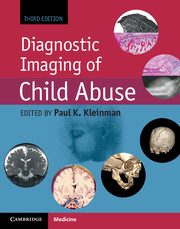Book contents
- Frontmatter
- Dedication
- Contents
- List of Contributors
- Editor’s note on the Foreword to the third edition
- Foreword to the third edition
- Foreword to the second edition
- Foreword to the first edition
- Preface
- Acknowledgments
- List of acronyms
- Introduction
- Section I Skeletal trauma
- Section II Abusive head and spinal trauma
- Section III Visceral trauma and miscellaneous abuse and neglect
- Section IV Diagnostic imaging of abuse in societal context
- Chapter 24 Psychosocial considerations
- Chapter 25 Child abuse and the law I: general issues for the radiologist
- Chapter 26 Child abuse and the law II: the radiologist in court and fundamental legal issues
- Chapter 27 The radiologist's response to child abuse
- Section V Technical considerations and dosimetry
- Index
- References
Chapter 26 - Child abuse and the law II: the radiologist in court and fundamental legal issues
from Section IV - Diagnostic imaging of abuse in societal context
Published online by Cambridge University Press: 05 September 2015
- Frontmatter
- Dedication
- Contents
- List of Contributors
- Editor’s note on the Foreword to the third edition
- Foreword to the third edition
- Foreword to the second edition
- Foreword to the first edition
- Preface
- Acknowledgments
- List of acronyms
- Introduction
- Section I Skeletal trauma
- Section II Abusive head and spinal trauma
- Section III Visceral trauma and miscellaneous abuse and neglect
- Section IV Diagnostic imaging of abuse in societal context
- Chapter 24 Psychosocial considerations
- Chapter 25 Child abuse and the law I: general issues for the radiologist
- Chapter 26 Child abuse and the law II: the radiologist in court and fundamental legal issues
- Chapter 27 The radiologist's response to child abuse
- Section V Technical considerations and dosimetry
- Index
- References
Summary
Introduction
Forensic evidence, and the opinions radiologists offer based on it, is critical to judges and juries, who must determine what happened and who is responsible in cases of alleged child abuse. A radiologist's expert testimony, for example, may help a fact-finder determine how a child was injured, whether by disease, inflicted injury, or accident. Expert testimony may also help establish when a child was injured, which can narrow the list of potential perpetrators to those who had access to the child.
The purpose of this chapter is to provide some insight into the legal system generally, and to help you understand your role as an expert or fact witness when child abuse issues are adjudicated in court. The chapter will also detail various obstacles testifying experts can expect at trial, including challenges to the reliability of expert medical testimony concerning “shaken baby syndrome” (SBS) or “abusive head trauma” (AHT). I hope the chapter will serve as a primer for the uninitiated and will provide useful additional information for the more experienced.
Civil and criminal legal proceedings: the basics
There are a variety of legal proceedings in various forums for which medical testimony may be useful or required. The primary distinction is between civil and criminal proceedings. Civil cases do not involve criminal penalties. That is, no one will go to jail as a result of a civil lawsuit. Instead, civil proceedings may result in money damages being paid, legal relationships being changed, or legal rights being defined. Criminal cases, on the other hand, may result in the deprivation of the defendant’s liberty. Because the stakes are so much higher in criminal proceedings, they differ from civil proceedings in a variety of ways. For example, prosecutors must prove their cases by a higher standard, and evidence in criminal cases may be subject to closer scrutiny to avoid violating the defendant’s constitutional rights. This section will sketch the basics of civil and criminal proceedings to familiarize testifying experts with the trial process.
- Type
- Chapter
- Information
- Diagnostic Imaging of Child Abuse , pp. 645 - 657Publisher: Cambridge University PressPrint publication year: 2015
References
- 1
- Cited by



